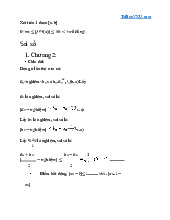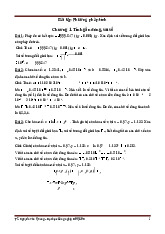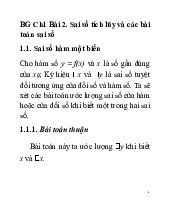



















Preview text:
lOMoAR cPSD| 58833082
BG Bài V.3 Xấp xỉ bình
phương tối thiểu liên tục bằng các hàm trực giao
1. Các hàm độc lập tuyến tính
A different technique to obtain least squares approximations will now be considered. This turns out to be
computationally efficient, and
once Pn(x) is known, it is easy
to determine Pn+1(x). To 1 lOMoAR cPSD| 58833082 facilitate the discussion, we need some new concepts.
Definition 1 The set of
functions {φ0, . . . , φn} is said
to be linearly independent on
[a, b] if, whenever
to we have c0 = c1 = · · · = cn = 0.
Otherwise the set of functions is
said to be linearly dependen 2 lOMoAR cPSD| 58833082 Ví dụ 1. a) Tập {1, x, …, xn} b) Tập {1, ex, …, enx}
c) Tập các hàm {sinkx/k=1, 2, …, n}
d) Xét họ đa thức
1, x – 1, (x – 1)2, …, (x – 1)n, ở
đây n >=2, có độc lập tuyến
tính trên [a, b] không? Giải
Đây là họ đa thức độc lập
tuyến tính trên [a, b] bất kỳ.
Theorem 2 Suppose that, for 3 lOMoAR cPSD| 58833082
each j = 0, 1, . . . , n, φj(x) is a
polynomial of degree j. Then
{φ0, . . . , φn} is linearly
independent on any interval [a, b]. Proof
Let c0, . . . , cn be real numbers for which
The polynomial P(x) vanishes
on [a, b], so it must be the zero
polynomial, and the coefficients 4 lOMoAR cPSD| 58833082
of all the powers of x are zero.
In particular, the coefficient of
xn is zero. But cnφn(x)is the only
term in P(x) that contains xn , so
we must have cn = 0. Hence
In this representation of P(x), the only term that contains a
power of xn-1 is cn-1 φn-1(x), so this term must also be zero and 5 lOMoAR cPSD| 58833082 In like manner, the remaining
constants cn-2, cn-3, . . . , c1, c0
are all zero, which implies that
{φ0, φ1, . . . , φn} is linearly
independent on [a, b].
Example 2 Let φ0(x) = 2, φ1(x)
= x - 3, and φ2(x) = x2 + 2x + 7,
and Q(x) = a0 + a1x + a2x2.
Show that there exist constants 6 lOMoAR cPSD| 58833082
c0, c1, and c2 such that Q(x) =
c0φ0(x) + c1φ1(x) + c2φ2(x).
Solution By Theorem 2, {φ0,
φ1, φ2} is linearly independent
on any interval [a, b]. First note that and Hence 7 lOMoAR cPSD| 58833082 The situation illustrated in Example 2 holds in a much
more general setting. Let Pn(x) denote the set of all polynomials of degree at most
n. The following result is used extensively in many
applications of linear algebra. Its proof is considered in Exercise 13. 8 lOMoAR cPSD| 58833082
Theorem 3 Suppose that
{φ0(x), φ1(x), . . . , φn(x)} is a collection of linearly
independent polynomials có bặc
nhỏ hơn hoặc bằng n. Then any
polynomial có bậc nhỏ hơn
hoặc bằng n can be written uniquely as a linear
combination of φ0(x),
φ1(x), . . ., φn(x). 9 lOMoAR cPSD| 58833082 Orthogonal Functions To discuss general function approximation requires the
introduction of the notions of weight functions and orthogonality.
Definition 4 An integrable
function w is called a weight
function on the interval I if
w(x) ≥ 0, for all x in I, nhưng nó
không đồng nhất bằng 0 trên
khoảng con bất kỳ nào của I. The purpose of a weight 10 lOMoAR cPSD| 58833082 function is to assign varying degrees of importance to approximations on certain portions of the interval. For example, the weight function places less emphasis near the
center of the interval (-1, 1) and
more emphasis when |x| is near
1 (see Figure 8.8). This weight 11 lOMoAR cPSD| 58833082 function is used in the next section.
Suppose {φ0, φ1, . . . , φn} is a set of linearly independent
functions on [a, b] and w is a
weight function for [a, b].
Given f C[a, b], we seek a linear combination to minimize the error 12 lOMoAR cPSD| 58833082 This problem reduces to the situation considered at the
beginning of this section in the
special case when w(x) ≡ 1 and
φk(x) = xk , for each k = 0, 1, . . . , n. The normal equations
associated with this problem are
derived from the fact that for
each j = 0, 1, . . . , n, 13 lOMoAR cPSD| 58833082
The system of normal equations can be written
If the functions φ0, φ1, . . . , φn can be chosen so that
then the normal equations will reduce to 14 lOMoAR cPSD| 58833082
for each j = 0, 1, . . . , n. These are easily solved to give Hence the least squares approximation problem is greatly simplified when the
functions φ0, φ1, . . . , φn are chosen to satisfy the
orthogonality condition in Eq. (8.7). The remainder of this 15 lOMoAR cPSD| 58833082
section is devoted to studying
collections of this type must be
solved for the (n + 1) unknowns
aj. The normal equations always have a unique solution
provided that f C[a, b]. (See Exercise 15.)
The word orthogonal means right-
angled. So in a sense, orthogonal
functions are perpendicular to one another. 16 lOMoAR cPSD| 58833082
Definition 5 {φ0, φ1, . . . , φn}
is said to be an orthogonal set
of functions for the interval [a, b] with respect to the weight function w if 17 lOMoAR cPSD| 58833082
in addition, αj = 1 for each j =
0, 1, . . . , n, the set is said to be
orthonormal.
This definition, together with the remarks preceding it,
produces the following theorem.
Theorem 6 If {φ0, . . . , φn} is
an orthogonal set of functions
on an interval [a, b] with respect to the weight function 18 lOMoAR cPSD| 58833082
w, then the least squares
approximation to f on [a, b] with respect to w is
where, for each j = 0, 1, . . . , n Although Definition 8.5 and Theorem 8.6 allow for broad
classes of orthogonal functions, we will consider only 19 lOMoAR cPSD| 58833082
orthogonal sets of polynomials. The next theorem, which is based on the Gram-Schmidt process, describes how to construct orthogonal
polynomials on [a, b] with
respect to a weight function w.
Theorem 7 The set of
polynomial functions {φ0,
φ1, . . . , φn} defined in the
following way is orthogonal on
[a, b] with respect to the weight function w: 20



